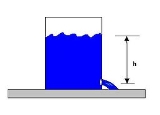
Torricelli's Law
Encyclopedia
Torricelli's law, also known as Torricelli's theorem, is a theorem in fluid dynamics
relating the speed of fluid flowing out of an opening to the height of fluid above the opening.
Torricelli's law states that the speed of efflux, v, of a fluid through a sharp-edged hole at the bottom of a tank filled to a depth h is the same as the speed that a body (in this case a drop of water) would acquire in falling freely from a height h, i.e. , where g is the acceleration due to gravity. This last expression comes from equating the kinetic energy gained,
, where g is the acceleration due to gravity. This last expression comes from equating the kinetic energy gained,  , with the potential energy lost, mgh, and solving for v.
, with the potential energy lost, mgh, and solving for v.
The law was discovered (though not in this form) by the Italian scientist Evangelista Torricelli
, in 1643. It was later shown to be a particular case of Bernoulli's principle
.
states that:

where v is fluid speed, g is the gravitational acceleration
, z is the fluid's height above a reference point, p is pressure, and ρ is density. Define the opening to be at z=Ø. At the top of the tank, p is equal to the atmospheric pressure. v can be considered 0 because the fluid surface drops in height extremely slowly compared to the speed at which fluid exits the tank. At the opening, z=Ø and p is again atmospheric pressure. Eliminating the constant and solving gives:



z is equivalent to the h in the first paragraph of this article, so:

Fluid dynamics
In physics, fluid dynamics is a sub-discipline of fluid mechanics that deals with fluid flow—the natural science of fluids in motion. It has several subdisciplines itself, including aerodynamics and hydrodynamics...
relating the speed of fluid flowing out of an opening to the height of fluid above the opening.
Torricelli's law states that the speed of efflux, v, of a fluid through a sharp-edged hole at the bottom of a tank filled to a depth h is the same as the speed that a body (in this case a drop of water) would acquire in falling freely from a height h, i.e.
 , where g is the acceleration due to gravity. This last expression comes from equating the kinetic energy gained,
, where g is the acceleration due to gravity. This last expression comes from equating the kinetic energy gained,  , with the potential energy lost, mgh, and solving for v.
, with the potential energy lost, mgh, and solving for v.The law was discovered (though not in this form) by the Italian scientist Evangelista Torricelli
Evangelista Torricelli
Evangelista Torricelli was an Italian physicist and mathematician, best known for his invention of the barometer.-Biography:Evangelista Torricelli was born in Faenza, part of the Papal States...
, in 1643. It was later shown to be a particular case of Bernoulli's principle
Bernoulli's principle
In fluid dynamics, Bernoulli's principle states that for an inviscid flow, an increase in the speed of the fluid occurs simultaneously with a decrease in pressure or a decrease in the fluid's potential energy...
.
Derivation
Bernoulli's principleBernoulli's principle
In fluid dynamics, Bernoulli's principle states that for an inviscid flow, an increase in the speed of the fluid occurs simultaneously with a decrease in pressure or a decrease in the fluid's potential energy...
states that:

where v is fluid speed, g is the gravitational acceleration
Gravitational acceleration
In physics, gravitational acceleration is the acceleration on an object caused by gravity. Neglecting friction such as air resistance, all small bodies accelerate in a gravitational field at the same rate relative to the center of mass....
, z is the fluid's height above a reference point, p is pressure, and ρ is density. Define the opening to be at z=Ø. At the top of the tank, p is equal to the atmospheric pressure. v can be considered 0 because the fluid surface drops in height extremely slowly compared to the speed at which fluid exits the tank. At the opening, z=Ø and p is again atmospheric pressure. Eliminating the constant and solving gives:



z is equivalent to the h in the first paragraph of this article, so:

See also
- Spouting canSpouting CanThe spouting can experiment is a physics experiment designed to show that, according to Torricelli's Law, in a liquid with an open surface, pressure increases with depth. It consists of a tube with three separate holes in and an open surface. The three holes are blocked, then the tube is filled...
experiment - Pascal's lawPascal's lawIn the physical sciences, Pascal's law or the Principle of transmission of fluid-pressure states that "pressure exerted anywhere in a confined incompressible fluid is transmitted equally in all directions throughout the fluid such that the pressure ratio remains the same." The law was established...

